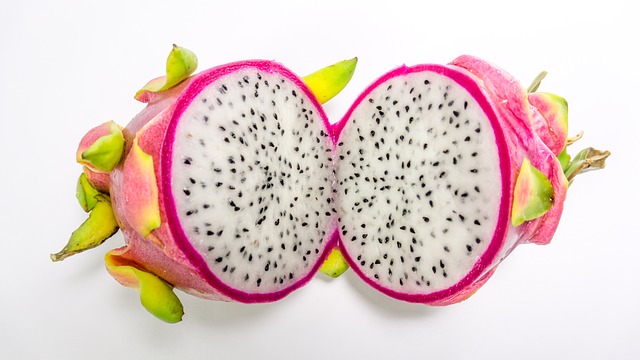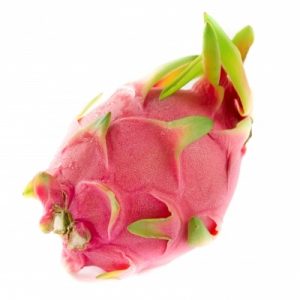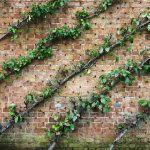
The red pitaya or pitahaya (Family: Cactaceae) also known as the dragonfruit, or pittaberry is an attractive deep red fruit which unusually comes from a number of different cactus species. Fresh dragon fruit is available globally and offers a colourful addition to the dinner table. It is particularly exotic and its appearance is very dramatic. The fruit is also turned into puree and juice.
A very effective review of the pitahaya has been written covering all the main features of the plant and its fruit (Ortiz-Hernández, Y. D., & Carrillo-Salazar, 2012).
This exotic cactus is native to Mexico and Central and South America but is now grown commercially in south-east Asia such as Malaysia and Thailand where the fruit has increasingly found a willing consumer in the USA and Europe.
We might also have seen the flower because it is called in horticultural circles as the Queen Of The Night, The Lady Of The Night or the Moonflower. It is highly distinctive as a white bloom and attracts bats to pollinate it.

There are two species of dragonfruit; Hylocereus polyrhizus and H. undatus (Haw.). Both have been the subject of a great deal of clinical research.
H. undatus is the most commonly grown species. The fruit is available from April to May or September through to November depending on which hemisphere it is grown in.
The fruit is generally covered in a thin, easily peelable rind and scales. The pulpy centre of the fruit is soft, delicate, juicy and contains copious quantities of small soft seeds. It is either red or white depending on species and variety. It is sweet tasting and said to be similar to kiwifruit.
Customers prefer the deep red to purple cultivars. The colour is not due to anthocyanins but to betalains which are mainly the red to purple betacyanins mixed in with betaxanthins (Azeredo et al., 2007) and offer excellent opportunities for the developer for water soluble and relatively stable colour.
The fruit is a very good source of vitamin C, some minerals and a variety of other bioactive compounds including flavonoids and polyphenols which also act as antioxidants (Wu et al., 2006). Pitaya flesh has the following characteristics: moisture content (87.3%), carbohydrate (1.48%), protein (0.16%), fat (0.23%), ascorbic acid (vitamin C) (0.9%), ash (0.7%), phenolic compounds (46.1 mg GAE [gallic acid equivalents] per 100 g), and dietary fibre (10.1%), (Khalili et al., 2006, 2009).
The peel is red to maroon and potential source of natural colour for the food industry as well as a potential source of fibre. Like the pulp it too is a source of betacyanins which would have potent antioxidant activity (Tenore et al., 2012).
Dragonfruit Carbohydrates
The carbohydrates in dragon fruit flesh are suitable as a prebiotic ingredient. The major types are glucose, fructose and some oligosaccharides (total concentrations of 86.2 and 89.6 g/kg, respectively) (Wichienchot et al., 2010). The oligosaccharides remain to be characterised but there are a number of interesting fractions. Their molecular weights are between 474 Da and 716 Da. What is most interesting about these are their resistance to hydrolysis by human gastric juice and alpha-amylase. The levels of hydrolysis are relatively benign at 4 per cent and 35 per cent respectively. Their interest as prebiotics comes from their ability to stimulate the growth of probiotic gut bacteria such as lactobacilli and bifidobacteria. Given the interest in probiotics, such ingredients should prove valuable in the further development of such beverages.
The antioxidant activity of various extracts of red flesh pitahaya has been examined using a variety of antioxidant assays (Adnan et al., 2010).
Dragonfruit Seed Oil
Both species are used to produce a seed oil. Essential fatty acids are present. These are linoleic acid and linolenic acid which form a significant percentage of the unsaturated fatty acids of the seed oil extract. Two oleic acid isomers have been isolated.
From a nutritional perspective, the essential fatty acids found serve as a useful additional source of nutrient because being essential they cannot be synthesized in the body. They used as substrates in the body as substrates for further fatty acid metabolism and synthesis of such compounds as arachidonic acid. More specifically, the seeds contain roughly 50 per cent by weight of two particular types (C18:2 (48-50%) and C18:3 (1.0-1.5%) (Ariffin et al., 2009). The other fatty acids are oliec acid (C18:1, 21 to 24%) and cis-vaccenic acid (C18:1, 2.8 -3.0%).
Dragonfruit Stems And Flower Buds
The young stems of H. undatus are edible (Castillo et al., 2005; Juárez-Cruz et al., 2012).
References
Adnan, L., Osman, A., & Abdul Hamid, A. (2011). Antioxidant activity of different extracts of red pitaya (Hylocereus polyrhizus) seed. International Journal of Food Properties, 14(6), pp. 1171-1181.
Ariffin, A. A., Bakar, J., Tan, C. P., Rahman, R. A., Karim, R., & Loi, C. C. (2009). Essential fatty acids of pitaya (dragon fruit) seed oil. Food Chemistry, 114(2), pp. 561-564 (Article).
Azeredo, M.C., Santos, A.N., Souza, A.C.R., Mendes, K.C.B., Andrade, M.I.R. (2007). Betacyanin stability during processing and storage of a microencapsulated red beetroot extract. Amer. J. Food Technol., 2,pp. 307–312
Castillo, M.R., Livera, M.M., Márquez, J.G. (2005) Caracterización morfológica y compatibilidad
sexual de cinco genotipos de pitahaya (Hylocereus undatus). Agrociencia 39 pp. 183-194.
Chang, Y. J., Pong, L. Y., Hassan, S. S., & Choo, W. S. (2019). Antiviral activity of betacyanins from red pitahaya (Hylocereus polyrhizus) and red spinach (Amaranthus dubius) against dengue virus type 2 (GenBank accession no. MH488959). Access Microbiology, acmi000073.
Ibrahim, S. R. M., Mohamed, G. A., Khedr, A. I. M., Zayed, M. F., & El‐Kholy, A. A. E. S. (2018). Genus Hylocereus: Beneficial phytochemicals, nutritional importance, and biological relevance—A review. Journal of Food Biochemistry, 42(2), e12491.
Khalili, R.M.A., Norhayati, A.H., Rokiah, M.Y., Asmah, R., Nasir, M.T.M. & Muskinah, M.S. (2006). Proximate composition and selected mineral determination in organically grown red pitaya (Hylocereus sp.). J. Tropical Agric. Food Sci., 34, pp. 269–275.
Khalili, R.M.A., Norhayati, A.H., Rokiah, M.Y., Asmah, R., Muskinah, M.S. & Manaf, A.A. (2009). Hypocholesterolemic effect of red pitaya (Hylocereus sp.) on hypercholesterolemia induced rats. Int. Food Res. J., 16, pp. 431–440
Lira, S. M., Dionísio, A. P., Holanda, M. O., Marques, C. G., da Silva, G. S., Correa, L. C., … & Guedes, J. A. C. (2020). Metabolic profile of pitaya (Hylocereus polyrhizus (FAC Weber) Britton & Rose) by UPLC-QTOF-MSE and assessment of its toxicity and anxiolytic-like effect in adult zebrafish. Food Research International, 127, 108701.
Nurul, S. R., & Asmah, R. (2014). Variability in nutritional composition and phytochemical properties of red pitaya (Hylocereus polyrhizus) from Malaysia and Australia. International Food Research Journal, 21(4).
Obenland, D., Cantwell, M., Lobo, R., Collin, S., Sievert, J., & Arpaia, M. L. (2016). Impact of storage conditions and variety on quality attributes and aroma volatiles of pitahaya (Hylocereus spp.). Scientia Horticulturae, 199, pp. 15-22.
Ortiz-Hernández, Y. D., & Carrillo-Salazar, J. A. (2012). Pitahaya (Hylocereus spp.): a short review. Comunicata Scientiae, 3(4), pp. 220-237
Santos, G. B. M., Dionísio, A. P., Magalhães, H. C. R., de Abreu, F. A. P., Lira, S. M., de Lima, A. C. V., … & Pontes, D. F. (2020). Effects of processing on the chemical, physicochemical, enzymatic, and volatile metabolic composition of pitaya (Hylocereus polyrhizus (FAC Weber) Britton & Rose). Food Research International, 127, 108710.
Tenore, G.C., Novellino, E., Basile, A. (2012) Nutraceutical potential and antioxidant benefits of red pitaya (Hylocereaus polyrhizus) extracts. J. Functional Foods. 4(1) pp. 129-136 (Article)
Tze, N. L., Han, C. P., Yusof, Y. A., Ling, C. N., Talib, R. A., Taip, F. S., & Aziz, M. G. (2012). Physicochemical and nutritional properties of spray-dried pitaya fruit powder as natural colorant. Food Science and Biotechnology, 21(3), pp. 675-682.
Wichienchot, S., Jatupornpipat, M., & Rastall, R. A. (2010). Oligosaccharides of pitaya (dragon fruit) flesh and their prebiotic properties. Food Chemistry, 120(3), pp. 850-857 (Article)
Wu, L., Hsu, H.W., Chen, Y.C., Chiu, C.C., Lin, Y.I., Ho, J.A. (2006). Antioxidant and antiproliferative activities of red pitaya. Food Chem. 95, pp. 319–327. (Article)
Yong, Y. Y., Dykes, G., Lee, S. M., & Choo, W. S. (2018). Effect of refrigerated storage on betacyanin composition, antibacterial activity of red pitahaya (Hylocereus polyrhizus) and cytotoxicity evaluation of betacyanin rich extract on normal human cell lines. LWT, 91, pp. 491-497.


Leave a Reply